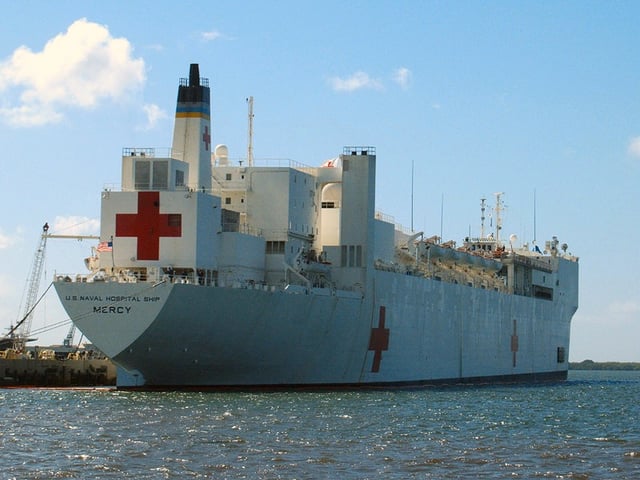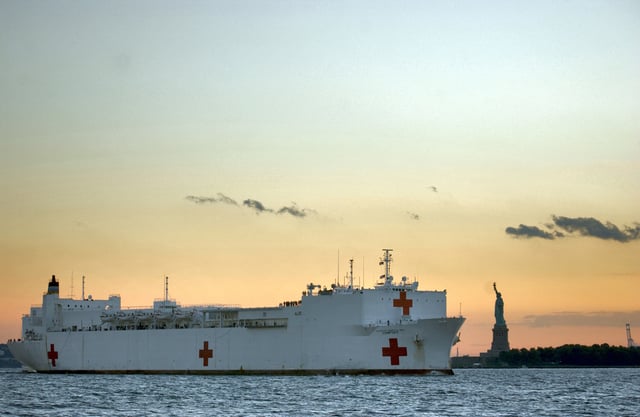Medical Corps (United States Navy)
-HKXweTF3cMuTmeAbJ2Il0rOZoib5aC)
Medical Corps (United States Navy)
-HKXweTF3cMuTmeAbJ2Il0rOZoib5aC)
| United States Navy Medical Corps | |
|---|---|
| Founded | March 3, 1871 (1871-03-03) |
| Country | |
| Branch | |
The Medical Corps of the United States Navy is a staff corps consisting of military physicians in a variety of specialties. It is the senior corps among all staff corps, second in precedence only to line officers. The corps of commissioned officers was founded on March 3, 1871.
Prior to the formal establishment of the corps, ships’ surgeons served without commissions, unless given one by the commanding officer. Those commissions would be for the duration of a specific cruise.
The Medical Corps is one of the four staff corps of the Navy's Bureau of Medicine and Surgery (BUMED), which is led by the Surgeon General of the United States Navy.
Facing a shortage of trained physicians to serve the needs of the Navy and Marine Corps, the Uniformed Services Health Professions Revitalization Act of 1972 was passed. This was a two-pronged act in which the Uniformed Services University of the Health Sciences and the Health Professions Scholarship Program were created.[2] In both programs, civilians are given a direct commission to the rank of ensign (O-1) in the United States Navy Reserve which they hold throughout the four years of their medical education. During this time they receive financial assistance on the condition that they meet reservist requirements, maintain military standards, and agree to serve on active duty as physicians. The commitment required is at least 4 years for HPSP and 7 years of service for USUHS students.
Upon graduation, the new physicians are promoted to the rank of lieutenant (O-3) and enter active duty as medical interns (PGY-1) at a Naval Hospital.
Upon completion of an internship year, a Navy physician can be deployed to the fleet as a General Medical Officer, though opportunities also exist to complete full-residency training in the specialty of their choice or undergo 6 months of training to become a Flight Surgeon or Undersea Medical Officer.
As of December 2015, VADM C. Forrest Faison III is the 38th Surgeon General of the United States Navy and is the highest-ranking officer of the Medical Corps. The Chief of the Medical Corps is RDML James L. Hancock, who concurrently serves as Medical Officer of the Marine Corps.[3]
| United States Navy Medical Corps | |
|---|---|
| Founded | March 3, 1871 (1871-03-03) |
| Country | |
| Branch | |
Qualifications and designations

USNS Mercy, a U.S. Navy hospital ship
Members of the Medical Corps are eligible to pursue qualification programs that lead to breast insignia such as:
Flight Surgeon Insignia (USA, USN, USAF)
Astronaut Badge
Surface Warfare Medical Corps Insignia
Submarine Medical Insignia
Diving (Medical) Insignia
Fleet Marine Force Insignia
Master Parachutist Badge
Seabee combat warfare specialist insignia
Ships named after physicians
Reference: Dictionary of American Naval Fighting Ships
USS Begor (DE-711)
USS Boone (FFG-28)
USS Bronstein (DE-189)
USS Bronstein (DE-1037)
USS Gendreau (DE-639)
USS Grayson (DD-435)
USS Heermann (DD-532)
USS J. Douglas Blackwood (DE-219)
USS Kane (DD-235)
USS Kane (AGS-27)
USS Longshaw (DD-559)
USS Pinkney (APH-2)
USS Pratt (DE-363)
USS Rall (DE-304)
USS Ringness (DE-590)
USS Rixey (APH-3)
USS Samuel S. Miles (DE-183)
USS Tryon (APH-1)
USS William M. Wood (DD-715)
USS Wood (DD-317)
USNS Charles Drew (T-AKE-10)
See also

USNS Comfort, a U.S. Navy hospital ship
Hospital Corpsman
Category:Medical battalions of the United States Marine Corps
Naval Center for Combat and Operational Stress Control
Naval Submarine Medical Research Laboratory
United States Navy Health Care
Navy Dental Corps
Navy Hospital Corps
Navy Medical Service Corps
Navy Nurse Corps
U.S. Air Force Medical Corps
U.S. Army Medical Corps
U.S. Navy hospital ships